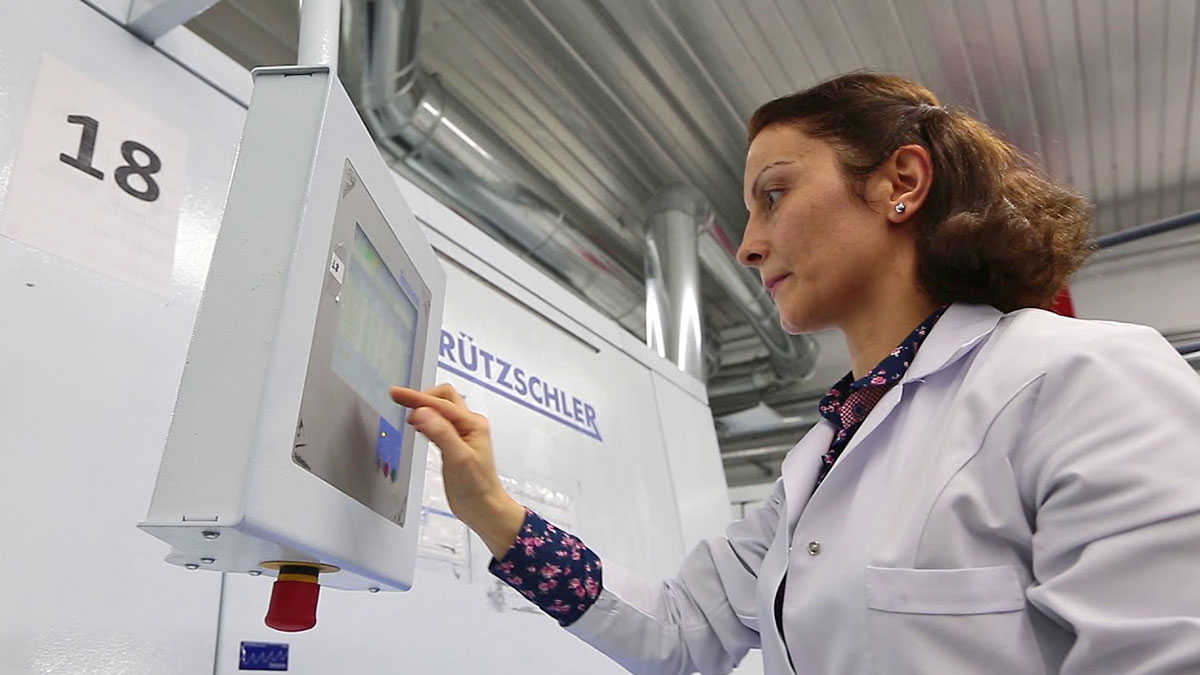Visits: 23
Based in Gaziantep, Gama İplik ve Dokuma Sanayi A.Ş., spins regenerated yarns from used textiles since 1997. One of Turkey’s leading textile manufacturers, the company have a daily production capacity of 100 tons of yarn and 50 tons of polyester fiber.
Yarns produced in three plants of Gama İplik are used in applications ranging from upholstery textiles to home textiles, from socks to cleaning cloths and packaging. However, the product range also includes special yarns with flame retardant or antibacterial coating and heavy metal-free bleached yarns for the food industry. Gama İplik has equipped all three facilities with Truetszchler machines. Various generations of cards, together with the automatic bail openers BLENDOMAT and the integrated draw frames (IDF2), contribute to the company in achieving particularly good yarn quality.
Eva Trenz from Truetzschler had an interview with Zafer Kaplan, owner of Gama İplik.
Gama Iplik is one of the world’s greatest regenerate spinners. This implies a lot of empirical knowledge. What are the typical raw materials you are using?
Zafer Kaplan: The bandwidth of the raw materials that we process ranges from textile production waste like rags, snippets or other textile waste to post-consumer material. Millions of tons of old textiles are collected every year, but qualities vary greatly.
What do you pay attention to when purchasing ‘good’ textile waste?
Zafer Kaplan: We prefer, and that is a great challenge, classified material sorted by color and type of material.
A great environmental problem are ultra-cheap clothes. Did the quality of the raw material change within the last years? And where do you purchase your raw material?
Zafer Kaplan: We mostly buy the rags and snippets in Turkey. PET bottles are mostly imported from all over the world. The quality of the snippets is indeed getting worse and worse in the last years in Turkey. We clearly note more contamination in the production process. The threads of the fancy items in clothing production are of a poor basic quality, unfortunately.
The various basic qualities certainly require a special approach to the processing of the raw materials. How do you sort and cut the textile waste?
Zafer Kaplan: There is no way around manual sorting. Our operators are very experienced in evaluating materials. Manual sorting is essential. Also we carry out precutting and shredding processes.
From your point of view: The main challenges of the textile recycling process are….
Zafer Kaplan: It’s all about good people and the best machinery. We attach great importance to that constantly growing experience of our team, whether management or operator. Also the capability, technology and quality of the production machines are very significant.
One of the hardest parts of your business is the production of constant quality. How do you manage it?
Zafer Kaplan: We have a well-trained laboratory team in our company which guides the operators with constantly acquired knowledge and which controls the whole production process.
What are the benefits of Truetzschler machines for your process and – of course – the yarn quality you achieve?
Zafer Kaplan: In our plant we have TC 03, TC 07, TC 11, TC 15, TC 19i, so to say: all types of Truetzschler cards. And we are very satisfied with the quality and the capability of the whole Truetzschler equipment. I would say they are the key machines in the regenerated spinning process.
How do you determine the mix of materials in your end product in view of the European Textile Labeling Act?
Zafer Kaplan: Of course we have a chemical laboratory. All necessary tests regarding the material composition are carried out there.
Sustainability is a big future issue for all of us. What challenges and developments do you expect for the future?
Zafer Kaplan: The competition is getting harder. There is a great demand for recycled yarn on the market, but what’s missing are enough good raw materials.
For which applications the produced yarn will be used?
Zafer Kaplan: We produce yarns for almost all textiles, clothing, upholstery, socks, carpets and much more. 50 percent of the production remains in Turkey, the other half is exported to 16 different countries, including Germany, Belgium and North America.

The first intelligent card from Truetzschler: TC 19i
The intelligent card TC 19i, which provides a 40% reduction in yarn imperfections and a 40% increase in production, provides an excellent carding range that remains constant even under changing production conditions with the Gap Optimizer T-GO. In addition, thanks to WASTECONTROL, which is part of the intelligent scanning process, 2% savings in raw material usage is achieved. Direct quality control with the nep sensor NEPCONTROL and digital process monitoring with My Mill can be performed. Controlling the TC 19i is as easy as using a phone with a SMART TOUCH monitor. In addition, the operator can see the operating status of the machine at a glance from anywhere in the spinning mill with the remote display system T-LED.

